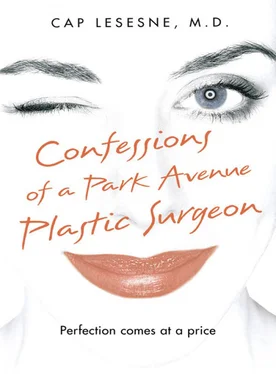Many of my patients are between forty and sixty, with the rest divided evenly between those older and younger. Women are particularly vulnerable during these decades. Their childbearing years are nearly over. Their kids are getting older. Their parents may be dying. They’ve become the elders, the generation in charge. Patients sit in my consult room and tell me things not even their husbands or girlfriends or best friends know. Essentially, they want me to restore a lost youth, back to when they were nineteen, or twenty-six, or thirty-five, or forty-seven. Their determination to rediscover happiness and self-assurance supersedes all else. “If I don’t look good after this face-lift,” said Lee, the seventy-year-old who shrugged off the heart attack she’d had immediately following her operation, “then nothing matters.”
I maintain a familiarity with my patients for brief periods or for much longer. Frequently, I get to know them well – maybe too well. I become friendly with many, travel with them, attend their weddings and even those of their children. Sometimes I’m invited to their post-divorce parties. It’s no wonder such a bond should form between patient and doctor. In doing something so intense and personal, and which can palpably improve lives, I can’t help but achieve a closeness unusual for doctor and patient. For my patients’ part, they can’t help but reveal themselves candidly to me. Part of this intimacy stems from the fundamental difference between elective and nonelective surgery. By the time prospective patients have chosen to appear in my office, they’ve thought deeply about personal and often painful subjects – their self-perception, how others regard them, and their goals.
During our introductory consultation, the patient and I will share pleasantries, then she’ll switch gears. For example, Renee, forty-two, suddenly tells me, “I’m meeting my old high school boyfriend next week, and I don’t look as good as I want to. Can you do a liposuction of my abdomen and legs and fat grafts for my lips in time?” (I can.) Or Frank, a New York TV anchorman, orders me to make him look younger by removing the fat bags in his lower eyelids, after his production manager comments on Frank’s late-night carousing – a particularly deflating comment since Frank spends his nights at home, prepping for work. (On-air TV personalities require a different surgical and aesthetic approach – more on that later – so I remove the fat by making incisions inside the eyelids. After surgery, Frank looks five years younger, with no visible scars, and misses only one weekend of work.) Or Danielle, a once beautiful, newly widowed social force in Palm Beach, complains that because of a disastrous surgery performed on her by a non-board-certified plastic surgeon, her face has deteriorated into a distorted, unnatural mask, with sweeping lines across her cheeks. “I’m desperate,” she says. “You have to help me.” (When I cut the multiple suspension sutures that distort her smile, her cheeks release and resume a more natural position; the results are apparent before the surgery is even done.)
And then there’s Liz.
A five-foot-five, seventy-three-year-old dynamo and legend in the public relations field, Liz seemed particularly pleased with my operations. She had asked me to change her breast implants three times in two years and was always happy with the way they turned out. A little smaller, a little bigger, then smaller again. C cup, now C+, now down to a B+. Although I initially balked at the second and third surgeries, Liz’s motivation seemed appropriate, and after much discussion, I believed she understood the limitations and risks (e.g., asymmetry, hardening, infection, bleeding) of each surgery.
Still, Liz looked somewhat anachronistic: youthful breasts on an aged body. But while this might tweak my aesthetic sense, Liz didn’t see it that way. She was thrilled.
I was neither flattered nor dismayed by Liz’s desire to routinely change her breast implants, but I was curious. I continued to probe for the reason behind the frequent adjustments. For more than two years, I got no satisfactory answer from her.
Six months after the third surgery, Liz comes to the office to discuss new implant set number four – and finally she cops to her motivation. “I change my breast size depending on who I’m dating,” she admits.
“Liz, I can’t do this anymore,” I tell her.
“Why do you care? It doesn’t hurt me, and it makes me feel good. Please,” she begs. “Just one more time.”
“No. Three is enough.” Each time an implant goes in, the body forms a layer, or capsule, of collagen, which can contract and distort the implant. While medically and technically there’s no reason I can’t continue to alter her breast size, I refuse, given her motivation, to do more surgery.
Liz scowls at me, not at all thrilled with my admonition.
“Can’t you put in a zipper?” she wonders.
Just because I want to help my patients doesn’t mean I always agree with their “reality.” Every now and then, I’m confronted by someone who seems to be looking in a fun-house mirror. Recently, I received this letter from Sapporo, Japan:
Dear Dr. Lesesne,
I understand you are a famous plastic surgeon.
My daughter looks like Elizabeth Taylor.
I would like her to look more Japanese.
Can you make her look more Japanese?
Thank you.
Sincerely,
It was signed by the girl’s mother.
Stapled to the letter was a photograph of a homely, very Japanese-looking fourteen-year-old girl.
Thanks to my unusual access to people seeking significant physical changes, I write this book, in part, to share what I’ve learned about what motivates us and what terrifies us.
My subjects are women and men seeking plastic surgery; my subject is the skin and tissue of aging faces and bodies. Over the course of my years in practice, I’ve seen an almost incessant burst of innovation – including lasers, Botox, collagen, Sculptra, Restylane, short-scar surgery, and endoscopic surgery – that has helped to improve results dramatically, while reducing bruising, scarring, and recovery time. Other medical innovations not specifically intended for plastic surgery have also helped the quality of the work and the patient experience. For example, the pulse oximeter, a device that measures the blood’s O 2level, allows us to monitor anesthesia continuously, thus making for safer, more accurate administration of sedation, as well as allowing for more office-based surgery. Versed, a Valium derivative, and fentanyl, a narcotic, have gained popularity because they are short-acting; when the surgery is over and we cease sedation, the aftereffects for the patient are gone within an hour, not days.
But it’s not just technical innovations and new drugs and the latest injectables that tantalize my patients. I’ve come to understand, after thousands of operations, a great deal about the anatomy of the face that isn’t found in anatomy textbooks. I’ve learned about light and shadow. About the way skin heals. About skin tension. About how much fat to remove (and whether to excise it or suction it). About where and why a surgeon should leave extra skin. About how best to disguise scars. About the false expectations of computer imaging. About why it’s crucial to examine the face over time and not just in the present. About which skin regimens work and which don’t. About a myriad of other lessons, large and small. All that knowledge has made my surgery of the face, in particular, far better today than when I did my first face-lift, in the winter of 1980, as a new surgical resident at Stanford University, assisting on a standard subcutaneous lift of a fifty-two-year-old mother of three.
Читать дальше












